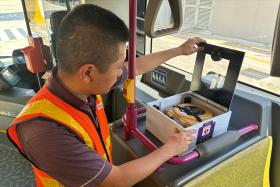Views: Are we really ready for PMD-sharing?
As companies vie for PMD-sharing licences, boundaries need to be set
This is the year of the big PMD push.
Call them what you will - personal mobility devices, e-scooters, catalysts for an explosion of pedestrian road rage on the pavements (pave rage?) - we are going to see more of them.
Seven companies are vying to get a licence to operate PMD-sharing services, and each could potentially put 500 e-scooters on the streets.
That may not seem a lot, but bear in mind that this is the initial phase. More could follow and that is not counting the privately owned devices.
The big question is: Are we ready for this?
When PMD-sharing was first mooted, it was hard not to picture it evolving into the Pixar film Wall-E, where humans had become so used to not having to walk, they lived in floating PMDs, getting increasingly fat.
At least with bike-sharing, you still get exercise.
If you were to ask if lessons had been learnt from the experiences of bike-sharing, you will probably get answers that relate to the companies' financial stability and due diligence.
No down payment needed will help increase popularity with users. And the need to charge e-scooters will reduce incidents of randomly discarded devices.
Well, that is the theory, at least.
The Land Transport Authority has said also it will heavily fine breaches of licence.
But for the man (or woman) in the street, are they ready for footpaths to be invaded?
Ask anyone who has encountered one of these halogen headlamped, glorified kick scooters zooming along a footpath, and they will tell you e-scooters are not pedestrian-friendly.
Right now, it feels like pedestrians will have to "make a way" to accommodate the rise in e-scooter numbers.
Not to paint all riders as speed demons who treat pedestrians as irritating obstacles, but these are devices anyone can ride - no prior experience needed.
You get on a bicycle only if you know how to ride it.
With PMD-sharing, all you need is an app, some (misguided?) self-belief that you can balance and away you go.
HOW FAST?
Which then brings us to speed. How fast is too fast for the pavement?
Anyone who has had an e-scooter silently skim by knows how annoying a scare it can be.
And while the top speed for PMDs on footpaths has been reduced to 10kmh from this year, past accidents have shown the level of harm that can be caused in an e-scooter collision.
For pedestrians, it will be time to be more mindful of their immediate surroundings.
Just a walk through a busy shopping mall will remind you of how unaware people can be of one another, whether they be phone zombies, shuffling along five abreast, or suddenly stopping in front of others.
We are all guilty of it.
But, it is one thing to bump into one another on foot. It is entirely another when one party is using a device that can cause harm - you'd better hope the rider's reflexes are up to par.
Introducing more PMDs, whose riders think they can weave through gaps between walkers, is a risk.
Grab, one of those vying for a licence, says it will educate the public.
Good to know, but can Grab succeed in getting the public on board?
As an example, take the markings at MRT platforms for people to wait at until others get out of the train - or a lift - before going in. Do we really follow the lines?
Again, this is not finger-wagging at impoliteness, just an acknowledgement of things that we do without thinking.
One hopes that more PMDs come with dedicated PMD lanes.
While giving people more options to travel is always welcome, the priority has to be for the safety of those most at risk - in this case, the pedestrians.
Get The New Paper on your phone with the free TNP app. Download from the Apple App Store or Google Play Store now



